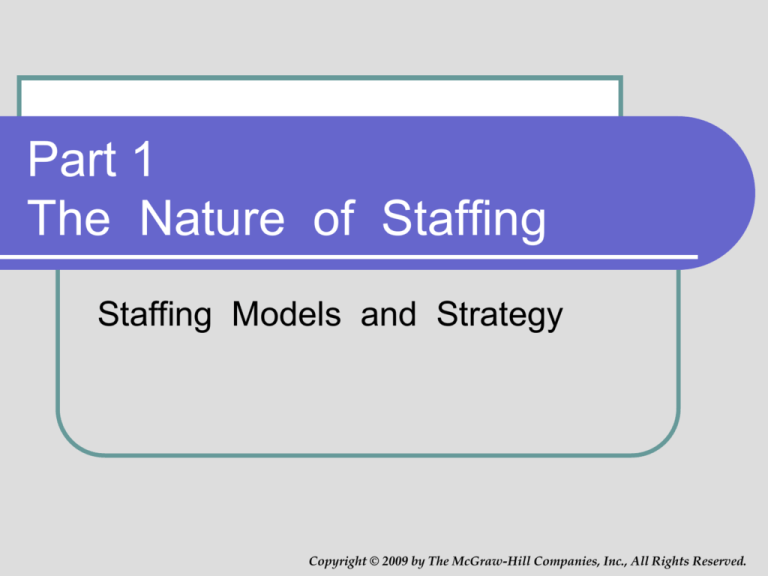
Part 1
The Nature of Staffing
Staffing Models and Strategy
Copyright © 2009 by The McGraw-Hill Companies, Inc., All Rights Reserved.
Staffing Organizations Model
Organization
Mission
Goals and Objectives
Organization Strategy
HR and Staffing Strategy
Staffing Policies and Programs
Support Activities
Core Staffing Activities
Legal compliance
Planning
Recruitment:
Selection:
External, internal
Measurement, external, internal
Job analysis
Employment:
Decision making, final match
Staffing System and Retention Management
1-2
Outline
Nature of Staffing
The Big Picture
Definition of Staffing
Implications of Definition
Staffing System
Examples
Staffing Models
Staffing Quantity: Levels
Staffing Quality:
Person/Job Match
Staffing Quality:
Person/Organization
Match
Staffing Models
Staffing System
Components
Staffing Organizations
Staffing Strategy
Staffing Levels
Staffing Quality
Staffing Ethics
Plan for Book
1-3
The Big Picture
Organizations are combinations of physical,
financial, and human capital
Human capital
Knowledge, skills and abilities of people
Their motivation to do the job
Scope of human capital
An average organization’s employee cost (wages
or salaries and benefits) is over 25% of its total
revenue
Organizations that capitalize on human capital have
a strategic advantage over their competitors
1-4
Nature of Staffing
Definition
“Staffing is the process of acquiring, deploying, and
retaining a workforce of sufficient quantity and
quality to create positive impacts on the
organization’s effectiveness.”
Implications of definition
Acquire, deploy, retain
Staffing as a process or system
Quantity and quality issues
Organization effectiveness
1-5
Nature of Staffing: Importance to
Organizational Effectiveness
Quotes from organization leaders
Staffing is absolutely critical to the success of every company
The new economy, very much the Internet and the
entrepreneurial opportunities it created intensified the
competition for outstanding people.
Rajat Gupta, Managing Director, McKinsey and Company
I think about this in hiring, because our business all comes
down to people…In fact, when I’m interviewing a senior job
candidate, my biggest worry is how good they are at hiring. I
spend at least half the interview on that.
Gail Hyland-Savage, COO, Michaelson, Connor, & Bowl
Jeff Bezos, CEO, Amazon
When you get the best people, you don’t have to worry as
much about execution, because they make it happen
Larry Johnston, Albertson’s
1-6
Staffing Models
Staffing Quantity
Levels
Staffing Quality
Person/Job Match
Person/Organization Match
Staffing System Components
Staffing Organizations
1-7
Staffing Quantity
1-8
Person/Job Match
1-9
Concepts: Person/Job Match Model
Jobs are characterized by
their requirements and
rewards
Individuals are characterized
via qualifications (KSAOS)
and motivation
These concepts are not new
or faddish, this is an enduring
model of staffing
Matching process involves
dual match
KSAOs to requirements
Motivation to rewards
Job requirements expressed
in terms of both
Tasks involved
KSAOs necessary for
performance of tasks
Job requirements often
extend beyond task and
KSAO requirements
1-10
Person/Organization Match
1-11
Concepts: Person/Organization
Match Model
Organizational culture and values
New job duties
Tasks that may be added to target job over time
“And other duties as assigned . . . “
Multiple jobs
Norms of desirable attitudes and behaviors for
employees
Flexibility concerns - Hiring people
who could perform multiple jobs
Future jobs
Long-term matches during employment relationship
1-12
Staffing System Components
1-13
Components of Staffing
Organizations Model
Organizational strategy
Mission and vision
Goals and objectives
HR strategy
Involves key decisions about size
and type of workforce to be
Acquired
Trained
Managed
Rewarded
Retained
May flow from organizational strategy
May directly influence formulation of organization strategy
1-14
Components of Staffing
Organizations Model (continued)
Staffing strategy
An outgrowth of the interplay between organization and HR
strategy
Involves key decisions regarding acquisition, deployment, and
retention of organization’s workforce
Support activities
Serve as foundation for conduct of core staffing activities
Core staffing activities
Guide development of recruitment, selection, and employment
programs
Focus on recruitment, selection, and employment of workforce
Staffing and retention system management
1-15
Strategic Staffing Decisions
Staffing Levels
Acquire or Develop Talent
Hire Yourself or
Outsource
External or Internal Hiring
Core or Flexible
Workforce
Hire or Retain
National or Global
Attract or Relocate
Overstaff or Understaff
Short- or Long-term
Focus
Staffing Quality
Person/Job or
Person/Organization
match
Specific or general
KSAOs
Exceptional or acceptable
workforce quality
Active or passive diversity
1-16
Suggestions for Ethical Staffing
Practice
Represent the organization’s interests.
Beware of conflicts of interest.
Remember the job applicant.
Follow staffing policies and procedures.
Know and follow the law.
Consult professional codes of conduct.
Shape effective practice with research results.
Seek ethics advice.
1-17
Ethical Issues
Issue 1
As a staffing professional in the human resources
department or as the hiring manager of a work unit,
explain why it is so important to represent the
organization’s interests, and what are some
possible consequences of not doing so?
Issue 2
One of the strategic staffing choices is whether to
pursue workforce diversity actively or passively.
First suggest some ethical reasons for the active
pursuit of diversity, and then suggest some ethical
reasons for a more passive approach.
1-18






